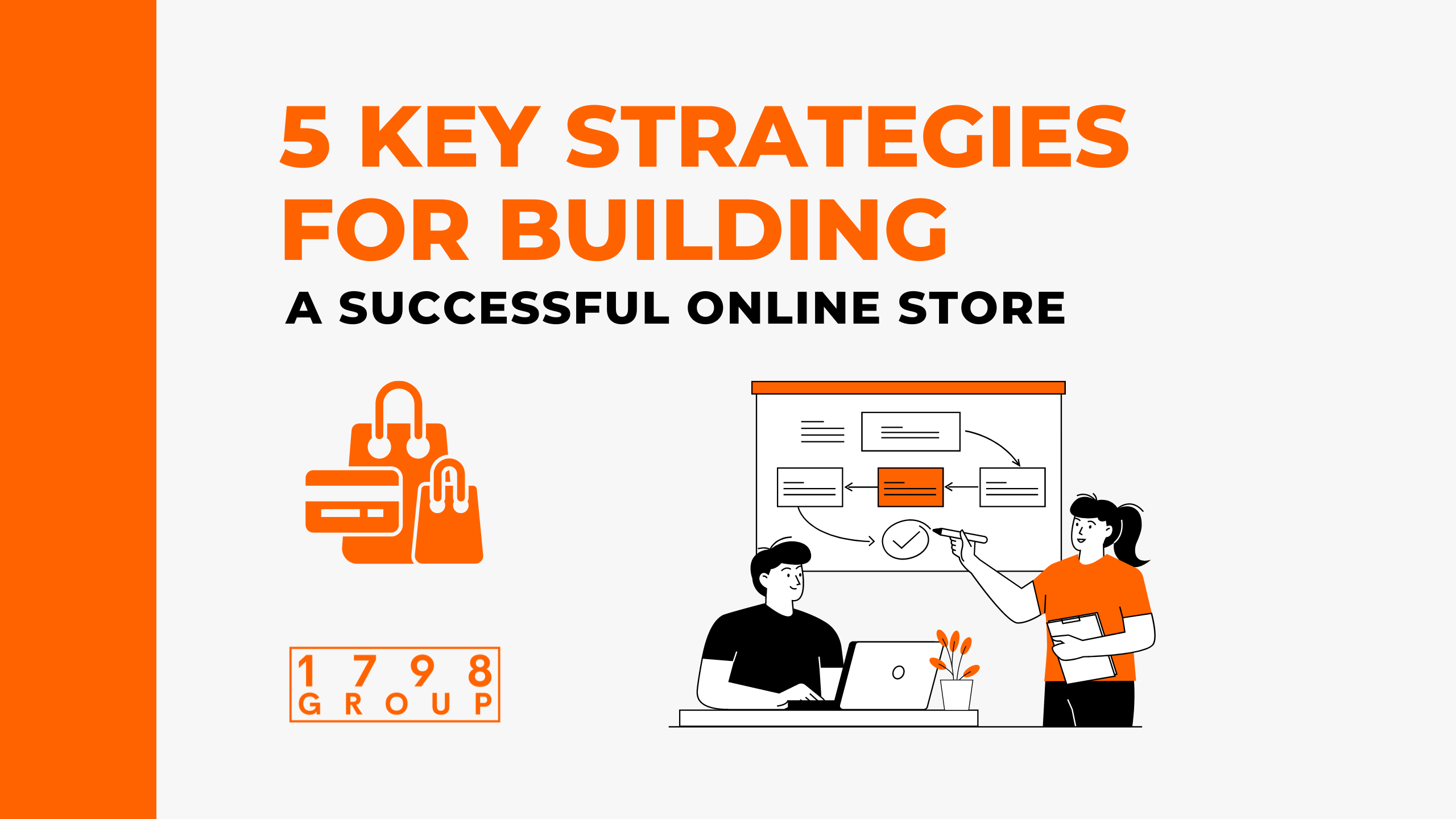
What we are going to cover in this article:
- Choose the Right E-Commerce Platform
- Customize Your Online Store’s Design
- Optimize Your Online Store for Mobile Devices
- Provide Excellent Customer Service
- Track Your Store’s Performance with Analytics
1. Choose the Right E-Commerce Platform
When building an online store, one of the most important decisions you’ll make is choosing the right e-commerce platform. The platform you choose will impact everything from your store’s design to its functionality, so it’s important to take the time to choose the right one for your business. There are several e-commerce platforms to choose from, including WooCommerce, Shopify, and BigCommerce. Each platform has its own strengths and weaknesses, so it’s important to evaluate your business needs and consider the following factors when making your decision:
Cost:
E-commerce platforms vary in cost, so it’s important to choose one that fits within your budget. Some platforms charge a monthly fee, while others charge a percentage of your sales.
Ease of Use:
Depending on your level of technical expertise, you may want to choose a platform that’s easy to use and doesn’t require a lot of coding or development skills.
Customization:
Some platforms offer more customization options than others. If you want a highly customized store, you may need to choose a platform that allows for more flexibility.
Features:
Different platforms offer different features, such as built-in tools, abandoned cart recovery, and customer reviews. Consider which features are important to your business and choose a platform that offers them.
Support:
When running an online store, it’s important to have access to reliable customer support. Choose a platform that offers quality support and resources to help you troubleshoot any issues that arise.
Once you’ve evaluated your business needs and considered the above factors, you can make an informed decision about which e-commerce platform is right for you. Remember that you can always switch platforms in the future if your needs change, but it’s important to start with a solid foundation that will support your business as it grows.
2. Customize Your Online Store’s Design
Customizing your online store’s design is an important step in creating a successful e-commerce business. Your store’s design is the first thing customers will see when they visit your site, and it can have a significant impact on their overall experience and the likelihood of making a purchase.
Here are some tips for customizing your online store’s design:
Choose a Theme:
Most e-commerce platforms offer a variety of themes that you can use to customize your store’s design. Choose a theme that aligns with your brand and makes it easy for customers to navigate your site.
Branding:
Ensure that your online store’s design reflects your brand identity. This includes using your brand colors, logo, and font. Consistency in branding helps build customer trust and loyalty.
Visuals:
Use high-quality images and videos to showcase your products. Customers are more likely to make a purchase when they can see what they’re buying in detail.
Navigation:
Ensure that your online store’s design is user-friendly and easy to navigate. Make it simple for customers to find what they’re looking for, with clear product categories and a search bar.
Call-to-Action:
Use clear call-to-action (CTA) buttons to guide customers toward making a purchase. This could include “Add to Cart” or “Buy Now” buttons that stand out on the page.
Mobile Optimization:
Ensure that your online store’s design is optimized for mobile devices. Many customers use their smartphones to shop online, so it’s important that your store is easily accessible and navigable on a mobile device.
By customizing your online store’s design, you can create a positive user experience for your customers and increase your chances of making a sale. Remember to keep your branding consistent, use high-quality visuals, and make it easy for customers to navigate your site.
3. Optimize Your Online Store for Mobile Devices
In today’s digital age, more and more customers are using their mobile devices to shop online. In fact, according to Statista, mobile devices accounted for 58.5% of global e-commerce sales in 2022. This means optimizing your online store for mobile devices is crucial to the success of your business.
Here are some tips for optimizing your online store for mobile devices:
Use a Responsive Design:
A responsive design ensures that your online store is easily accessible and navigable on all types of devices, including smartphones and tablets. This means that your site will automatically adjust to the screen size of the device used.
Simplify Your Design:
When designing for mobile devices, it’s important to keep things simple. Avoid cluttered layouts and complex menus, and make sure your site is easy to navigate with a minimum of clicks.
Optimize Your Images:
Large images can slow down your site’s load time, which can be frustrating for mobile users. Optimize your images for the web and consider using smaller file sizes or compressed formats like WebP.
Streamline the Checkout Process:
Ensure that your checkout process is optimized for mobile devices. This could include using autofill forms, offering mobile payment options like Apple Pay or Google Wallet, and minimizing the number of steps required to complete a purchase.
Use Mobile-Friendly CTAs:
Ensure that your call-to-action (CTA) buttons are easy to tap and clearly visible on a mobile device. Make sure they are big enough to tap with a thumb and use contrasting colors to make them stand out.
4. Provide Excellent Customer Service
Customer service is a critical aspect of any business, and it’s no different for an online store. In fact, providing excellent customer service can set your online store apart from competitors and build loyalty with your customers. Here are some tips for providing excellent customer service:
Be Responsive:
Respond to customer inquiries and concerns promptly, ideally within 24 hours. This can be done through email, social media, or a live chat feature on your website. Make it easy for customers to contact you and ensure that you have a process in place for handling customer service inquiries.
Offer Multiple Channels of Support:
Different customers prefer different methods of communication, so it’s important to offer multiple channels of support. This could include email, phone, social media, and live chat.
Personalize Your Communications:
Personalized communications can go a long way in building a relationship with your customers. Address them by name, acknowledge their concerns, and offer personalized solutions to their problems.
Be Transparent:
Be upfront with customers about your policies, including shipping times, returns, and refunds. Provide clear information on your website and ensure that customers are aware of any potential issues before making a purchase.
By providing excellent customer service, you can build loyalty with your customers and create a positive reputation for your online store. Remember to be responsive, offer multiple channels of support, personalize your communications, be transparent, and follow up with customers.
5. Track Your Store’s Performance with Analytics
Tracking your online store’s performance is essential to understanding how it’s performing and identifying areas for improvement. Analytics provide valuable insights into your store’s traffic, sales, and customer behavior, allowing you to make data-driven decisions to improve your business. Here are some tips for tracking your store’s performance with analytics:
Set Up Analytics:
First, you’ll need to set up an analytics tool to track your online store’s performance. Google Analytics is a popular option that provides comprehensive insights into your website’s traffic, behavior, and conversions.
Define Your Key Metrics:
Identify the key metrics that are most important to your business, such as conversion rate, average order value, and bounce rate. These metrics will help you understand how your store is performing and where to focus your efforts to improve.
Monitor Your Traffic:
Keep an eye on your website traffic to understand how users are interacting with your site. Monitor the number of visitors, page views, and time on site to identify trends and patterns.
Analyze Your Sales:
Analyze your sales data to understand which products are selling the most and where you’re generating the most revenue. Use this information to optimize your product offerings and pricing strategy.
In conclusion, building a successful online store requires careful consideration of various factors such as choosing the right e-commerce platform, customizing the store’s design, optimizing it for mobile devices, providing excellent customer service, and tracking its performance with analytics. A solid foundation that supports your business as it grows is essential. However, it is important to note that creating an online store from scratch can be a challenging task if you are new. That’s why we offer a complete online store-building service that takes care of all the technical details, design, customization, optimization, and support, leaving you free to focus on growing your business. So, whether you’re starting a new online store or looking to upgrade your existing one, we’ve got you covered.



